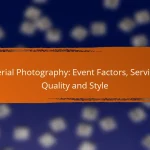What are the applications of aerial photography in real estate?
Aerial photography plays a crucial role in real estate by providing unique perspectives that enhance property marketing, site analysis, development planning, and inspections. These applications help real estate professionals make informed decisions and present properties more effectively.
Property marketing
Aerial photography significantly enhances property marketing by showcasing listings from unique angles. High-quality images can highlight the property’s surroundings, such as nearby amenities, parks, and transportation links, making listings more appealing to potential buyers.
Using aerial shots in marketing materials can increase engagement and interest, often leading to faster sales. Real estate agents should consider incorporating drone footage or aerial images in online listings, brochures, and social media campaigns.
Site analysis
Aerial photography is invaluable for site analysis, allowing real estate professionals to assess land features and surrounding infrastructure. By capturing images from above, analysts can identify zoning issues, environmental concerns, and access routes that may not be visible from the ground.
When conducting site analysis, it is essential to utilize high-resolution images to ensure clarity in evaluating potential development sites. This can help in making strategic decisions regarding land use and investment opportunities.
Development planning
In development planning, aerial photography assists in visualizing large areas for potential projects. Planners can use aerial images to understand the layout of the land, existing structures, and how new developments will integrate into the surrounding environment.
Incorporating aerial photography into development plans can facilitate better communication with stakeholders and regulatory bodies. It is advisable to keep updated images to reflect any changes in the landscape or zoning regulations that may impact the project.
Drone inspections
Drone inspections utilize aerial photography to assess properties and structures efficiently. Drones can capture detailed images of rooftops, facades, and hard-to-reach areas, reducing the need for scaffolding or ladders, which can be time-consuming and costly.
When conducting drone inspections, ensure compliance with local regulations regarding drone usage. Regular inspections using aerial photography can help identify maintenance issues early, ultimately saving property owners money and time in repairs.
How is aerial photography used in agriculture?
Aerial photography is utilized in agriculture primarily for monitoring crop health, enhancing precision farming practices, and creating detailed field maps. By capturing images from above, farmers can assess crop conditions, optimize resource usage, and plan for better yields.
Crop monitoring
Crop monitoring through aerial photography allows farmers to observe plant health and growth patterns from a unique vantage point. High-resolution images can reveal variations in color and density, indicating areas that may require more attention or resources.
Farmers can use this information to identify issues such as pest infestations, nutrient deficiencies, or water stress early on, enabling timely interventions that can save costs and improve yields.
Precision farming
Precision farming leverages aerial photography to enhance decision-making processes in agriculture. By analyzing aerial images, farmers can implement targeted interventions, such as applying fertilizers or pesticides only where needed, which can lead to significant cost savings and reduced environmental impact.
This approach often involves using data analytics to process the images, allowing for the creation of prescription maps that guide the application of inputs with high accuracy.
Field mapping
Aerial photography is essential for creating detailed field maps that outline various features such as soil types, drainage patterns, and crop boundaries. These maps provide a comprehensive overview of the agricultural landscape, aiding in planning and management decisions.
Farmers can utilize these maps to optimize field layouts, enhance irrigation strategies, and improve overall farm management. Regular updates to these maps can help track changes over time, ensuring that farming practices adapt to evolving conditions.
What role does aerial photography play in environmental monitoring?
Aerial photography is crucial for environmental monitoring as it provides a bird’s-eye view of ecosystems, allowing for detailed observation and analysis. This method helps in tracking changes over time, assessing impacts of human activities, and guiding conservation efforts.
Wildlife tracking
Aerial photography is used to monitor wildlife populations and their habitats effectively. By capturing images from above, researchers can identify animal movements, nesting sites, and migration patterns without disturbing the animals. This non-intrusive method is particularly useful for tracking endangered species in remote areas.
For example, aerial surveys can reveal the locations of herds or breeding grounds, providing data that can inform conservation strategies. Drones equipped with cameras can cover large areas quickly, making them an efficient tool for wildlife management.
Deforestation assessment
Aerial photography plays a vital role in assessing deforestation by providing clear visuals of forest cover changes over time. It allows environmentalists to identify areas of illegal logging, land conversion for agriculture, or natural disasters affecting forested regions.
Regular aerial surveys can help track deforestation rates, enabling governments and organizations to implement policies or interventions. For instance, comparing images from different years can highlight trends and facilitate discussions on sustainable land use practices.
Pollution mapping
Aerial photography is instrumental in mapping pollution sources and their impacts on the environment. By capturing images of industrial sites, waterways, and urban areas, it helps identify hotspots of contamination, such as oil spills or waste discharge points.
This visual data can be used to assess the extent of pollution and guide remediation efforts. For example, aerial images can show changes in water quality in lakes or rivers, prompting further investigation and action to protect these ecosystems.
How can businesses benefit from aerial photography?
Businesses can leverage aerial photography to enhance their operations, marketing, and project assessments. By capturing images from above, companies gain unique perspectives that can improve decision-making and increase engagement with their audiences.
Marketing campaigns
Aerial photography can significantly enhance marketing campaigns by providing stunning visuals that capture attention. Businesses can use aerial shots to showcase properties, landscapes, or events, making their promotional materials more appealing.
For effective marketing, consider using high-resolution images that highlight key features. Aerial images can be integrated into social media, websites, and brochures, often leading to higher engagement rates compared to traditional photography.
Event documentation
Using aerial photography for event documentation allows businesses to capture the scale and atmosphere of gatherings from a unique vantage point. This approach is particularly useful for large events like festivals, weddings, or corporate functions.
When documenting events, ensure that the photographer is familiar with the venue and can anticipate key moments. Aerial shots can provide a comprehensive overview, making it easier to promote future events or create memorable keepsakes.
Infrastructure assessment
Aerial photography is a valuable tool for infrastructure assessment, enabling businesses to inspect and monitor structures like bridges, roads, and buildings efficiently. This method allows for quick evaluations without the need for extensive ground access.
Consider using aerial imagery to identify maintenance needs or assess damage after natural disasters. Regular aerial surveys can help in planning repairs and ensuring compliance with safety regulations, ultimately saving time and costs in the long run.
What are the prerequisites for using aerial photography?
To effectively use aerial photography, one must understand the necessary regulatory compliance and select appropriate equipment. These prerequisites ensure that the aerial photography process is both legal and technically sound.
Regulatory compliance
Before engaging in aerial photography, it is essential to comply with local regulations regarding airspace and drone usage. In many countries, including the United States and those in the European Union, operators must obtain specific licenses and adhere to guidelines set by aviation authorities.
For instance, in the U.S., the Federal Aviation Administration (FAA) requires drone operators to register their aircraft and follow Part 107 rules if they are using drones for commercial purposes. Familiarizing yourself with these regulations can help avoid fines and legal issues.
Equipment selection
Choosing the right equipment is crucial for successful aerial photography. This includes selecting a suitable drone, camera, and any additional accessories like gimbals or lenses. Drones equipped with high-resolution cameras can capture detailed images, while stability features help reduce motion blur.
When selecting a drone, consider factors such as flight time, range, and payload capacity. For example, drones with flight times exceeding 20 minutes are often preferred for extensive aerial shoots. Additionally, ensure the camera has a minimum resolution of 12 megapixels for quality images.






